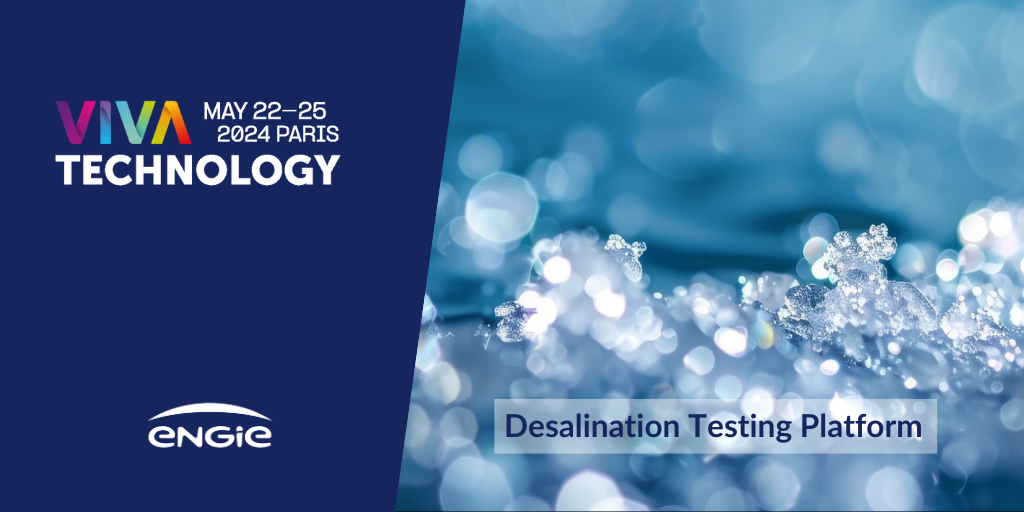

Seawater desalination represents great hope.
Without access to clean water, there can be no progress in health care. Fresh water is also essential for crop production. This resource meets a primary, essential need which, if it isn’t met, could generate conflicts between states and give rise to major migratory crises. We are already seeing this with the increase in water stress in several regions of the world. That is why seawater desalination represents great hope. We are devoting ourselves to seawater desalination on a large scale, with the aim of constantly improving our operational excellence.
Putting things very simply, in the past, seawater was desalinated by thermal distillation. Over the last twenty years or so, or slightly longer, we have been moving towards more energy efficient technologies, such as reverse osmosis, which uses renewable electricity - solar or wind power. Reverse osmosis is a filtration technology that works by forcing pressurised water through the tiny pores of a semi-permeable membrane. This membrane retains seawater ions, in other words the minerals, and only allows the water molecules to pass through.
ENGIE is a leader in this field. Desalination is one of the Group's key activities in the Middle East. In the Persian Gulf, we operate nine sites and produce almost 6 million cubic metres of drinking water every day. That's a considerable amount. 10 million people are estimated to be currently supplied with this water. The idea is to increase this capacity to 9 million cubic metres per day. Furthermore, this business is set to expand geographically.
With Marie-Laure Thielens, Desalination Research Program Manager, we are working on a pilot platform that will enable us to carry out small-scale trials in order to optimise our process. It is being built in Sharjah, in the north of Dubai, and we will then move it to an industrial site in the south of Dubai.
In fact, there are three stages in desalination: water pre-treatment, reverse osmosis and post-treatment. The reverse osmosis (RO) units are the first building blocks of our test platform. We're in the process of building the water pre-treatment unit, then we'll start working on the post-treatment unit. In this way, we will gradually rebuild an entire small-scale desalination unit.
The idea is to experiment with new technologies, equipment and products - such as better-performing, less expensive membranes that can be changed less often, or even manufactured using 3D printing. We will also be testing new configurations, for example, that are more energy-efficient. The aim of this pilot is to obtain tangible data and draw up recommendations for our operators, which will then be applied on a large scale at the Group's industrial sites.
Using a 3D animation, a model of a desalination plant and a reverse osmosis membrane, we will show how reverse osmosis works in our pilot desalination plant. It will give us an opportunity to explain the technical, financial and human issues involved in desalination.
Apart from the opportunity to educate the general public, we want to improve our visibility and connect more closely with the world of start-ups. They could, for example, help us to further reduce the carbon footprint of our facilities, or help us produce the consumable chemicals necessary for the desalination operation. When you desalinate seawater, you obtain fresh water on one side, and a residue with a slightly higher concentration of salt, a brine, on the other. One of our challenges is to recycle this waste.
I'm thinking of the steam engine, which heralded the start of the industrial revolution, but which also is the source of all our problems, because the industrial revolution led to CO2 emissions, and therefore global warming. There are also many wonderful scientific and human stories, such as the discovery of the electric battery by Volta, the Italian physicist. To achieve this, he stacked several layers of metal and salt-water imbibed felt. Who would have thought of doing that! But he thought it was possible, and he was right. Jules Verne was also a visionary, back in 1875, in The Mysterious Island, he predicted that the hydrogen and oxygen that make up water would one day provide us with electricity. That was 150 years ago. Only a crazy person would have believed this was possible. I tell myself that if they were alive and working today, we'd be telling them "What on earth is your business model?” or "Stop, it's pointless, there's no market for that", as we do with start-ups nowadays. And they'd be a bit surprised!
In the very short term, our aim is to see our pilot installation set up and operated on an industrial site, and for it to deliver useful results for operations. It should be the case in June. We have so much faith in it that we're already building its little sister!